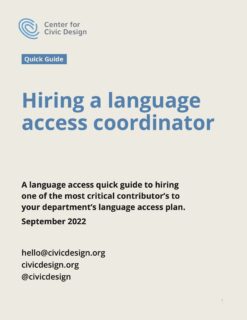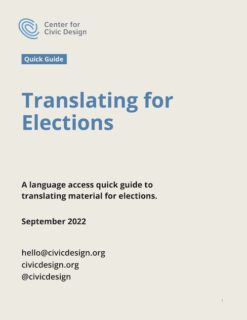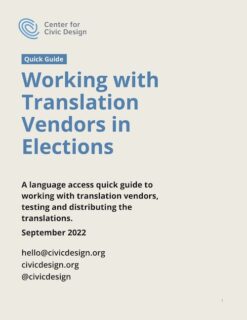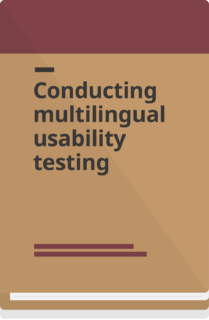Language access
Meeting voters’ language access needs
Providing access to information about voting and elections in languages other than English is bigger than simply delivering good translations of printed materials. A good language access program invites people with low English proficiency into the voting process. It acts as a bridge for new citizens who may be navigating a new language and a new civic system simultaneously. And it proactively builds relationships with community organizations that serve speakers of other languages.
We’ve tackled designing materials in multiple languages at every stage of the voter journey, from ballots to voter information to vote by mail envelopes and many, many forms. We’ve also done stand alone research projects to better understand the unique challenges that multilingual voters face.
Tools
Planning language access
Trying to help a community in your jurisdiction that needs voting materials in a language other than English? When CCD…
Hiring a language access coordinator
A language access quick guide to hiring one of the most critical contributor’s to your department’s language access plan.
Translating for elections
This quick guide contains a few best practices to consider in an internal civic translation process.
Working with translation vendors in elections
Guidance on how to choose a translation vendor, and how to work with them.
Conducting multilingual usability testing
This workbook will help you through the process of testing materials in multiple languages, and provide you with tools to run usability testing from pre-planning to reporting on what you learned.
Presentations
On beyond translation: Designing for language access
2018 EAC Language Access for Voters Summit: Session 4: Trends in Election Administration and their Impact on Language Access (2018)
Language access through design
2017 EAC Language Access Summit (June 6, 2017)
Video of the session
Research
Bilingual youth voters
In a series of moderated interviews, we set out to hear stories from bilingual citizens about their experiences to discover pain points and barriers to accessing voter registration information, civic engagement, and the next steps in the voting process.
Research with new citizens
In 2019, we took a deep dive into the experience of new citizens in civic life. The participants in our study revealed that acculturation is as important as language access, and that includes levels of civic literacy that natural-born citizens often don’t think of.
We learned that building a relationship with your new country is complicated:
- Enough English for a naturalization interview isn’t enough to take an active part in community and civic life.
- Learning to navigate new rights and responsibilities can be overwhelming.
- People who are struggling to get established don’t have time or resources to learn how the system works or what the issues are.
- Positive experiences with government help people feel motivated.
- Participating in civic life and community means different things in different countries.
From this, we learned how important it is to demystify the process of voting. Election departments can:
- Provide materials for how to prepare to vote.
- Make information available across channels and media, including ethnic media outlets.
- Help people feel seen and respected by introducing yourself and your office
- Work with trusted intermediaries (like cultural and heritage community organizations)
- Run mock elections so new citizens can practice voting.
And most of all, have a plan to develop your communications and poll worker training to be sensitive to the needs of new citizens.
Vietnamese language election workshop
What kinds of resources best support non-native English speakers to cast their ballot? We collaborated with the League of Women Voters Texas and Boat People SOS in Houston, the largest Vietnamese human and civil rights organization in Texas to run a focus group for Vietnamese-speaking seniors in Houston. These conversations were vital in shedding light on the importance of language and community to the civic engagement and voting experience.
Workshop report: Hội Thảo Bầu cử: Vietnamese language election workshop report
Implications for ballots and voting systems
We looked across all the sources we could find — about 40 that span topics from political science to law, to studies by advocacy groups — to understand what is known now about challenges and best practices for providing voter information and education in languages other than English. Some key insights include:
- There is little guidance on designing multi-language ballots and other materials for optimal usability by voters.
- With coverage determinations made every 5 years, requirements for language coverage may change within the expected life of a voting system.
- To be effective, poll worker training needs to include bilingual poll worker support for language access.
- Voters often are not aware that they could get materials in their preferred language.
- Voting machines must support bilingual ballot printing and Unicode languages.
- Voting systems must support audits in English, even if the ballot is in a language other than English.
This landscape analysis reveals that there are lots of questions to answer about how best to support election administrators and voters. It’s an area that we could be working on for some years (which we look forward to) to answering some questions like these:
Translation and transliteration
- Are there any situations in which computer-generated translations are acceptable?
- When transliteration is offered, what kinds of quality control can check for accuracy and consistency, especially within short timelines?
Voting systems
- What core requirements from VVSG apply to ballots and associated information about voting used by voters with low English proficiency?
- How can systems used in polling places and vote centers offer a consistent experience for voters with low English proficiency from beginning to end of the voting experience?
Ballots
- For paper ballots, what is the best multi-language layout for ballot measures that have long text?
- On digital ballots, should there be a specific requirement that digital interfaces be designed to toggle between languages rather than mixing them on the screen?
- How are English names pronounced when they are on a screen with another language? Is recorded speech more successful at mixing languages?
White paper on designing election systems for language access
We started, as part of a project for the National Institute of Standards and Technology (NIST), to explore the challenges that jurisdictions face in meeting language access requirements under the Voting Rights Act (VRA), Section 203. It’s a fascinating — and fluid — space to be in.
Language assistance under the VRA affects voters who are Asian American, Alaska Native, American Indian, and persons of Spanish heritage who have low English proficiency. Right now, about 22 million eligible voting-age citizens are covered under Section 203. Who are they? Where are they? And how can election administrators best serve them?
We developed the first white paper on this topic to understand the state of the coverage and service. We are actively seeking funding to answer the research questions above and to develop prototypes and templates to share with election officials.
Other resources
Glossaries of Election Terminologies from the Election Assistance Commission
CCD’s work on language access was made possible through support from the Chan Zuckerberg Initiative, the Democracy Fund, and other generous funders.






